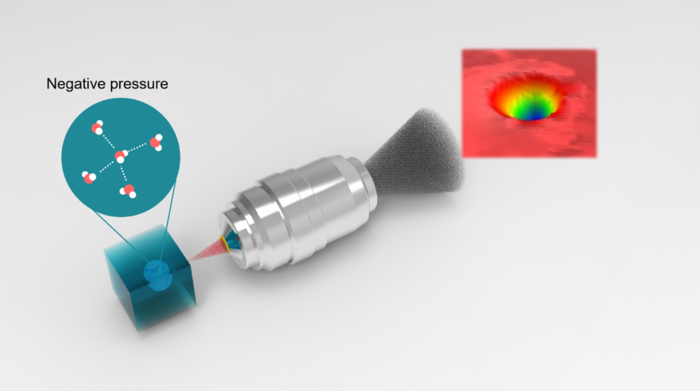Water, unexpectedly, has the potential to withstand a massive stretching force or tension due to its internal cohesive force. Under extreme tension, the hydrostatic pressure of the water would display as absolute negative. The comprehension of such a unique thermodynamic non-equilibrium state in the phase diagram of water is still blurry, which has sparked a lot of curiosity in the field. Nevertheless, after botanists discovered it in the xylem of trees first, this so-called negative pressure of stretched water could be designed to generate extremely large pressure differences. It has been employed in a series of advanced heat and mass transfer applications, including the on-chip synthetic tree for continuous water extraction, nanoporous membranes with ultrahigh interfacial heat fluxes, and so on.

Credit: Shihao Xu, Xiaowei Liu, Zehua Yu & Kang Liu
Water, unexpectedly, has the potential to withstand a massive stretching force or tension due to its internal cohesive force. Under extreme tension, the hydrostatic pressure of the water would display as absolute negative. The comprehension of such a unique thermodynamic non-equilibrium state in the phase diagram of water is still blurry, which has sparked a lot of curiosity in the field. Nevertheless, after botanists discovered it in the xylem of trees first, this so-called negative pressure of stretched water could be designed to generate extremely large pressure differences. It has been employed in a series of advanced heat and mass transfer applications, including the on-chip synthetic tree for continuous water extraction, nanoporous membranes with ultrahigh interfacial heat fluxes, and so on.
Researchers at Wuhan University in China, led by Prof. Kang Liu, devised a non-contact optical characterization approach to precisely detect the value of negative pressure of stretch water, particularly in microfluidic systems. This method prevents direct contact with stretched water and reduces the need for complicated measurement components. Their idea is to start with the deformation of the hydrogel surface caused by the extremely large negative pressure accumulating in the hydrogel voids. By establishing a link between negative pressure in the hydrogel voids and the deformation of the hydrogel surface, the exact value of negative pressure could be derived based on the extent of deformation and the measured geometrical parameters of the hydrogel voids. Moreover, the researchers also prove its further potential applications such as mapping the negative pressure of a dynamic flow in the microchannel. The work entitled “Non-contact optical characterization of negative pressure in hydrogel voids and microchannels” was published in Frontiers of Optoelectronics on Apr. 14, 2022.
###
About Higher Education Press
Founded in May 1954, Higher Education Press Limited Company (HEP), affiliated with the Ministry of Education, is one of the earliest institutions committed to educational publishing after the establishment of P. R. China in 1949. After striving for six decades, HEP has developed into a major comprehensive publisher, with products in various forms and at different levels. Both for import and export, HEP has been striving to fill in the gap of domestic and foreign markets and meet the demand of global customers by collaborating with more than 200 partners throughout the world and selling products and services in 32 languages globally. Now, HEP ranks among China’s top publishers in terms of copyright export volume and the world’s top 50 largest publishing enterprises in terms of comprehensive strength.
The Frontiers Journals series published by HEP includes 28 English academic journals, covering the largest academic fields in China at present. Among the series, 13 have been indexed by SCI, 6 by EI, 2 by MEDLINE, 1 by A&HCI. HEP’s academic monographs have won about 300 different kinds of publishing funds and awards both at home and abroad.
About Frontiers of Optoelectronics
Frontiers of Optoelectronics (FOE) aims at introducing the most recent research results and the cutting edge improvements in the area of photonics and optoelectronics. It is dedicated to be an important information platform for rapid communication and exchange between researchers in the related areas. The journal publishes review articles, research articles, letters, comments, special issues, and so on. The Editors-in-Chief are Academician Qihuang Gong from Peking University and Prof. Xinliang Zhang from Huazhong University of Science and Technology. FOE has been indexed by ESCI, Ei, SCOPUS, CSCD, Source Journals for Chinese Scientific and Technical Papers and Citations, etc. FOE is fully open access since 2022.
Journal
Frontiers of Optoelectronics
DOI
10.1007/s12200-022-00016-5
Method of Research
Experimental study
Subject of Research
Not applicable
Article Title
Non-contact optical characterization of negative pressure in hydrogel voids and microchannels
Article Publication Date
14-Apr-2022




